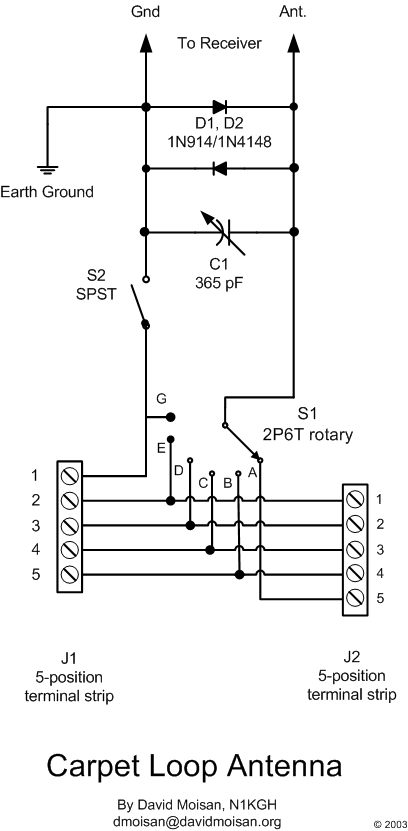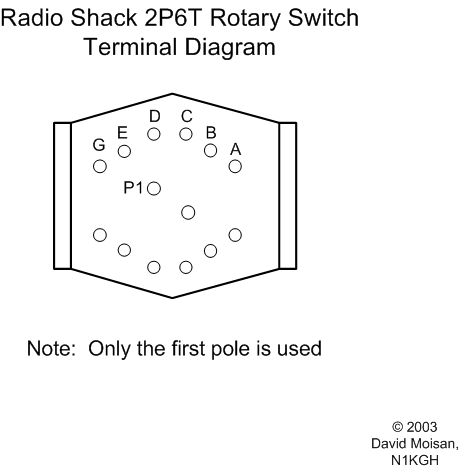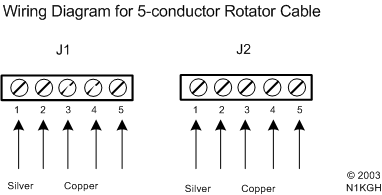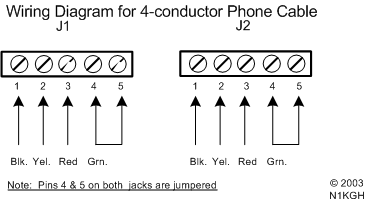The Carpet Loop -- A High Performance Indoor SW Antenna
Designed by David Moisan, N1KGH
Available Formats
In addition to the HTML version you see here, these plans are
also available in Zipped HTML or PDF.
Introduction
There are many shortwave listeners who can't, because of
location, infirmity or a unyielding landlord, put up an outside
antenna. Such people are given two choices--random wire or active
antenna. Yet, for the serious listener, neither choice is
completely adequate.
Active antennas are expensive, apt to generate as much noise
as signal, and are prone to overload. Random wires are cheap
(cheapest, in fact) and easy to put up, but are unpredictable
performers. Both subject the receiver to intermod, spurious
signals and other trash.
The Carpet Loop is an ideal step upward for the listener who
wants something better than a random wire but doesn't want the
expensive dice roll of an active antenna.
The Carpet Loop is made up of two components: A tuner, and the
antenna cable itself; the cable can be either 5-conductor rotator
cable or 4-conductor flat phone cable, both readily available
from Radio Shack and elsewhere. The tuner couples the antenna to
the radio, forming a (giant!) L-network. To tune the antenna, you
turn a switch for best reception.
While NO antenna can give a cheap receiver the sensitivity,
selectivity, or dynamic range it never had, the Carpet Loop will
help you get the last ounce of performance out of your radio.
Several years ago, I was using a random wire. I had severe
problems with a local AM station (2 miles away) on 1230 Khz. I
was hearing intermod from it all over the 9 to 12 Mhz range.
With the Carpet Loop (which was then just the cable), the
interference was almost completely gone. Also, the signals I was
receiving seemed to be just a little bit stronger. A year later,
I built the tuner, with much better results. I'm convinced I have
the best possible antenna for my location.
If you're stuck in an apartment, if you have a portable like
the Grundig Yacht Boy 400 or the Sangean 505 or 909, or if you
have a tabletop receiver, the Carpet Loop may be for you. It's
cheap--around $25 in parts from Radio Shack, *much* less if you
shop around, and an excellent first project for the technically
minded.
Carpet Loop Schematic

Parts List
Other items
Enclosure (either metal or plastic, RS ), jack to receiver,
banana jack for earth grounding .
Antenna cable
See construction
How the Carpet Loop Works
S1, C1, and the antenna cable connected to J1 and J2 form an
L-network; when S1 is switched between positions A through F, and
C1's capacitance is varied, the impedance of the antenna system
changes. When S1 and C1 are adjusted for best signal, the
impedance between antenna and receiver is matched. D1 and D2
provide protection against static discharges. The G position of
S1 grounds the antenna when not in use. S2 disconnects the ground
from the antenna, making the antenna into a random wire.
Parts Availability
With the exception of C1, all parts for the tuner are readily
available from Radio Shack. C1, the 365 pf variable capacitor,
can be gotten out of an old radio.
You may need to dig around for antenna rotator cable. Radio
Shack no longer sells 6-conductor rotator cable, though they do
sell 3-conductor cable. Either use two of these rotator cables,
or else use 4 or 6 conductor flat or round phone cable. Network cable is widely
available, but I have not tried it. In theory, the twisted pairs
may impede reception. Or not.
.
Subsitutions
There are no critical parts in the tuner; as long as S1 has at
least six positions, it will do. D1 and D2 can be any silicon
diode. Use any enclosure that's big enough to comfortably install
components in.
The choice for J3, the jack to the receiver, depends on what
connector your radio uses for an external antenna. I used an
SO-239 (RS #278-201).
Step-by-step Instructions
- Mount the components on the enclosure you'll be using--all
wiring is point to point. I suggest mounting J1 and J2 on
opposite sides, S1 and C1 on top, and J3 on the other end of the
enclosure.
-
Wire S1 to J1 and J2. If you use the Radio Shack DP6T rotary
switch, you'll be using just one of the poles. The diagram of the
switch is below:

Wire as follows:
(Note: If you're using the Radio Shack terminal strip, you will
need to drill a hole in the cabinet to pass the wires through
from inside. Use a rubber grommet to keep the wires from chafing
and fraying)
S1 Term. --to--> J2 term. J1 term. --to--> J2 term.
A #10 #2 #6
B #9 #3 #7
C #8 #4 #8
D #7 #5 #9
E #6
Connect a wire from J1 terminal #1 to the G terminal on S1,
and this step is done.
- Install and wire C1. Connect one terminal of C1 to the P
terminal on S1. Connect the other end to J3. If using the SO239
or phono jack, connect to the center conductor. If using screw
terminals, connect to terminal #1 on J3. Skip ahead to step
5.
- Connect the P1 terminal of S1 to J3. If you're using the
SO239 or phono jack, connect to the center conductor. If you're
using screw terminals, connect to terminal #1 on J3.
- Connect the G terminal on S1 to J3. Connect it to the ground
shield if it's an SO239 or phono jack, or to terminal #2 if it's
screw terminals.
- Connect D1 and D2 across J3's terminals; remember that D2 is
connected opposite of D1.
That completes construction of the tuner.
Antenna Construction
Choosing cable
The kind of cable you use depends on where you're putting it
and how much you're willing to pay for it.
If you plan on running it under carpet, then use the
5-conductor rotator cable mentioned in the parts list. This cable
can easily withstand being stepped on; more importantly, there
are no exposed wires to trip over. It's also easier to wire than
phone cable. (In my old apartment, this cable was still good when
I pulled it out of the carpet it sat under for 3 years. The
carpet, on the other hand, was shot.)
If you're not running it underfoot, or if you're cheap, you
can use 4-conductor flat phone cable, available just about
everywhere. It's a good choice for running around baseboards,
around windows or in attics.
When running the cable around, start at your receiver and go
around the room--or the house--and back to the radio. If you're
using the rotator cable, you can make corners by folding the
cable at a 45 degree angle, like origami. (In the computer
industry, there used to be an art to folding ribbon cables; if
you've ever seen an old DEC minicomputer, you know what I'm
referring to.)
I have used lengths of 25 to 30 feet for my carpet loops; this
is enough cable to go around the average-sized room. It also
seems to be optimal for the SW bands, though I've never had it
tested with an impedance bridge. (Anyone with a bridge is welcome
to send me their results!)
Wiring the cable to the tuner
You should have two ends of the cable next to the tuner. Strip
the ends and put spade lugs on all the wires. With the rotator
cable, mark the silver conductor.
Next, connect the wire to the tuner using the following
diagrams:


Grounding
Run a wire--preferably a large one--from the ground terminal
on the tuner (or a mounting screw on the SO239 connector if
you're using one) to a suitable ground such as a cold water pipe;
I grounded my tuner with a short length of RG58 coax connected to
a baseboard heater via an alligator clip.
Connect the tuner to your receiver; you're now ready to use
it.
Using The Carpet Loop
It's easier to use than to talk about: Tune your receiver to
the desired frequency. Adjust S1 and C1 (or the antenna trimmer
on the radio) for strongest signal. For most situations, S2
(Loop/Longwire) can be left closed in the Loop position; you may
find that setting S2 to Longwire may work better for mediumwave
listening.
Conclusion
The Carpet Loop is an inexpensive, easily built, high
performance antenna that can work in almost all apartments.
Contacting the Author
I can be reached at the following addresses:
Email:dmoisan@davidmoisan.org
WWW:
http://www.davidmoisan.org/
Let me know how the Carpet Loop works for you!
Dave
David Moisan
dmoisan@davidmoisan.org
Copyright © 1998, 2003, David Moisan
Last updated on April 4th, 2003
http://www.davidmoisan.org/radio/carpetloop/carpetloop.html
About
davidmoisan.org



